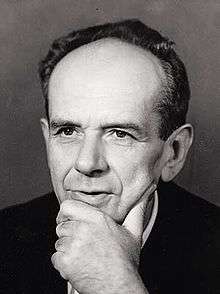Antoni Kępiński
| Antoni Kępiński | |
|---|---|
 Antoni Kępiński | |
| Born |
November 16, 1918 Dolina near Stanisławów |
| Died |
June 8, 1972 Kraków, Poland |
| Citizenship | Polish |
| Nationality | Polish |
| Fields | Psychology, Psychiatry |
| Known for | information metabolism, axiological psychiatry |
Antoni Kępiński (November 16, 1918 – June 8, 1972) was a Polish psychiatrist.
He attended the Bartłomiej Nowodworski High School. In 1936 he entered the Medical Faculty of the Jagiellonian University. In 1939, he interrupted his studies before graduation and volunteered for the Polish Army to defend his country from the German invasion. After the successful invasion of Poland by Germany, Kępiński was captured and imprisoned in Hungary, to where he had fled. In 1940, he managed to escape imprisonment and headed to France, then Spain, where he was imprisoned in Miranda del Ebro.
Later he was freed and came to Britain, spending a short time with the Polish aircraft division. In 1944-5, he continued his medical studies in Edinburgh graduating in 1946. Soon he returned to Poland and took up psychiatry at the Psychiatric Clinic of Collegium Medicum in Kraków.
As a concentration camp inmate himself he took part in a rehabilitation programme for survivors from the Auschwitz concentration camp.
Information metabolism
Information metabolism is a psychological theory of human social interactions based on information processing . It was developed in Eastern Europe by Kępiński. In the late 1970s, Lithuanian psychologist Aušra Augustinavičiūtė created socionics, a personality typology based on the typology of Carl Jung and Kępiński's theory of information metabolism.
According to Augustinavičiūtė, humans can be classified in terms of types of information processing, or "information metabolism". Psychological features such as attention, interests, memory and motivation are components of this theory of information metabolism. This theory of information metabolism is built upon an analogy to biological metabolism. According to this analogy, information that arrives as signals from outside an organism are available for information metabolism just as food is available for energy metabolism. The brain is the key information metabolism system. The brain and information metabolism deal with a two-way flow of signals: metabolism of input signals results in the production of output. Just as enzymes can constructively interact only with structurally specific substrate molecules, brains can only constructively metabolize information that is correctly "tuned" to the brain. By assigning "energy values" to the various psychological components of information metabolism, Augustinavičiūtė created a mathematical theory of thinking.
See also
References
- Bielecki, A. (2000) A mathematical model of Kepinski's information metabolism model theory. Proceedings of the Sixth National Conference on Application of Mathematics in Biology and Medicine, Zawoja, 9-13.
- Kępiński, A. (1972) Rytm życia (Rhythm of life), Kraków: Wydawnictwo Literackie.
- Kępiński, A. (1977) Melancholia (Melancholy), Warszawa, Państwowy Zakład Wydawnictw Lekarskich.
- Kępiński, A. (1977) Psychopatie (Psychopathy), Warszawa: Państwowy Zakład Wydawnictw Lekarskich.
- Kępiński, A. (1979) Schizofrenia (Schizophrenia), Warszawa: Państwowy Zakład Wydawnictw Lekarskich.
- Kokoszka, A. (1993) Information metabolism as a model of consciousness. International Journal of Neuroscience, Vol. 68 (3-4), pp. 165–77.
- Kokoszka, A. (1994) A rationale for multileveled model of relaxation. International Journal of Psychosomatics, Vol. 41, pp. 4–10.
- Kokoszka, A. (1999) Information metabolism as a model of human experiences. International Journal of Neuroscience, Vol. 97 Issue 3/4, pp. 169–10.
- Kokoszka, A. (2001) Mental organization according to the metabolism of information model and its mathematical description. International Journal of Neuroscience, Vol. 107 Issue 3/4, pp. 173–12.
- Struzik, T. (1987) Kepinski's functional structures. Kohonen's topological structures aphasia and apraxia. International Journal of Neuroscience, Vol. 36, pp. 113–118.
- Struzik, T. (1987) Kepinski's information metabolism. Carnot's principle and reformation theory. International Journal of Neuroscience, Vol. 36 (1-2), pp. 105–11.
- Zych A. A., Higiena psychiczna w Polsce. Słownik biograficzny. (Mental hygiene in Poland. Biographical dictionary). Wrocław: Wyd. nauk. DSW, 2013, pp. 114–117.
Bibliography
His theories of information metabolism and axiological psychiatry are well known and his scientific work covers over 140 publications and several books.
His books:
- Psychopatologia nerwic (Psychopathology of Neuroses)
- Schizofrenia (Schizophrenia)
- Melancholia (Melancholy)
- Psychopatie (Psychopathologies)
- Lęk (Fear)
- Podstawowe zagadnienia współczesnej psychiatrii (The Basic Concepts of Contemporary Psychiatry)
- Poznanie chorego (Understanding the Patient)
- Rytm życia (The Rhythm of Life)
External links
| Wikiquote has quotations related to: Antoni Kępiński |
- Life Circle, Time and the Self in Antoni Kępiński's Conception of Information Metabolismdead -- Published in 2007 in Poland
- Life Circle, Time and the Self in Antoni Kępiński's Conception of Information Metabolism
|